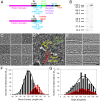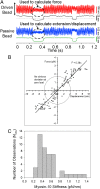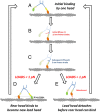Myosin-10 produces its power-stroke in two phases and moves processively along a single actin filament under low load
- PMID: 24753602
- PMCID: PMC4020102
- DOI: 10.1073/pnas.1320122111
Myosin-10 produces its power-stroke in two phases and moves processively along a single actin filament under low load
Abstract
Myosin-10 is an actin-based molecular motor that participates in essential intracellular processes such as filopodia formation/extension, phagocytosis, cell migration, and mitotic spindle maintenance. To study this motor protein's mechano-chemical properties, we used a recombinant, truncated form of myosin-10 consisting of the first 936 amino acids, followed by a GCN4 leucine zipper motif, to force dimerization. Negative-stain electron microscopy reveals that the majority of molecules are dimeric with a head-to-head contour distance of ∼50 nm. In vitro motility assays show that myosin-10 moves actin filaments smoothly with a velocity of ∼310 nm/s. Steady-state and transient kinetic analysis of the ATPase cycle shows that the ADP release rate (∼13 s(-1)) is similar to the maximum ATPase activity (∼12-14 s(-1)) and therefore contributes to rate limitation of the enzymatic cycle. Single molecule optical tweezers experiments show that under intermediate load (∼0.5 pN), myosin-10 interacts intermittently with actin and produces a power stroke of ∼17 nm, composed of an initial 15-nm and subsequent 2-nm movement. At low optical trap loads, we observed staircase-like processive movements of myosin-10 interacting with the actin filament, consisting of up to six ∼35-nm steps per binding interaction. We discuss the implications of this load-dependent processivity of myosin-10 as a filopodial transport motor.
Keywords: actomyosin; myosin X; myosin-5a; optical trapping; stable single alpha-helix.
Conflict of interest statement
The authors declare no conflict of interest.
Figures







Similar articles
-
Higher plant myosin XI moves processively on actin with 35 nm steps at high velocity.EMBO J. 2003 Mar 17;22(6):1263-72. doi: 10.1093/emboj/cdg130. EMBO J. 2003. PMID: 12628919 Free PMC article.
-
Kinetic characterization of nonmuscle myosin IIb at the single molecule level.J Biol Chem. 2013 Jan 4;288(1):709-22. doi: 10.1074/jbc.M112.424671. Epub 2012 Nov 12. J Biol Chem. 2013. PMID: 23148220 Free PMC article.
-
The SAH domain extends the functional length of the myosin lever.Proc Natl Acad Sci U S A. 2009 Dec 29;106(52):22193-8. doi: 10.1073/pnas.0909851106. Epub 2009 Dec 15. Proc Natl Acad Sci U S A. 2009. PMID: 20018767 Free PMC article.
-
The chemical mechanism of myosin-I: implications for actin-based motility and the evolution of the myosin family of motor proteins.Cell Struct Funct. 1996 Oct;21(5):351-6. doi: 10.1247/csf.21.351. Cell Struct Funct. 1996. PMID: 9118240 Review.
-
Myosin VI: a multifunctional motor.Biochem Soc Trans. 2004 Nov;32(Pt 5):685-8. doi: 10.1042/BST0320685. Biochem Soc Trans. 2004. PMID: 15493988 Review.
Cited by
-
A model for the chemomechanical coupling of myosin-V molecular motors.RSC Adv. 2019 Aug 27;9(46):26734-26747. doi: 10.1039/c9ra05072h. eCollection 2019 Aug 23. RSC Adv. 2019. PMID: 35528596 Free PMC article.
-
Nidogen1-enriched extracellular vesicles accelerate angiogenesis and bone regeneration by targeting Myosin-10 to regulate endothelial cell adhesion.Bioact Mater. 2021 Oct 27;12:185-197. doi: 10.1016/j.bioactmat.2021.10.021. eCollection 2022 Jun. Bioact Mater. 2021. PMID: 35310379 Free PMC article.
-
Dynamics of ATP-dependent and ATP-independent steppings of myosin-V on actin: catch-bond characteristics.J R Soc Interface. 2020 Apr;17(165):20200029. doi: 10.1098/rsif.2020.0029. Epub 2020 Apr 8. J R Soc Interface. 2020. PMID: 32259459 Free PMC article.
-
Computational Tool for Ensemble Averaging of Single-Molecule Data.Biophys J. 2021 Jan 5;120(1):10-20. doi: 10.1016/j.bpj.2020.10.047. Epub 2020 Nov 26. Biophys J. 2021. PMID: 33248132 Free PMC article.
-
Chaperone-enhanced purification of unconventional myosin 15, a molecular motor specialized for stereocilia protein trafficking.Proc Natl Acad Sci U S A. 2014 Aug 26;111(34):12390-5. doi: 10.1073/pnas.1409459111. Epub 2014 Aug 11. Proc Natl Acad Sci U S A. 2014. PMID: 25114250 Free PMC article.
References
-
- Richards TA, Cavalier-Smith T. Myosin domain evolution and the primary divergence of eukaryotes. Nature. 2005;436(7054):1113–1118. - PubMed
-
- Berg JS, Derfler BH, Pennisi CM, Corey DP, Cheney RE. Myosin-X, a novel myosin with pleckstrin homology domains, associates with regions of dynamic actin. J Cell Sci. 2000;113(Pt 19):3439–3451. - PubMed
-
- Berg JS, Cheney RE. Myosin-X is an unconventional myosin that undergoes intrafilopodial motility. Nat Cell Biol. 2002;4(3):246–250. - PubMed
-
- Zhu XJ, et al. Myosin X regulates netrin receptors and functions in axonal path-finding. Nat Cell Biol. 2007;9(2):184–192. - PubMed
Publication types
MeSH terms
Substances
Grants and funding
LinkOut - more resources
Full Text Sources
Other Literature Sources
Molecular Biology Databases

